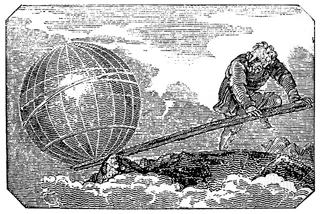 |
| Give me a place to stand and I will move the earth. Archimedes of Syracuse (ca. 287-212 BCE) |
|---|
M-3 SIMPLE MACHINES
1. PURPOSE:
To study the operation of various kinds of simple machines, and to analyze them in terms of mechanical advantage, displacement ratio, efficiency, etc.
2. APPARATUS:
Various machines, meter stick, metric weights, spring balances, string, lab. hardware.
3. THEORY:
First some definitions of words commonly used. A machine is a mechanical device that is capable of doing useful work on something else. Not all devices or mechanisms this, so they are not properly called machines. However, many machines do work, but doing work is not their primary purpose. The hinged lid of a box is a simple lever, but when we open the box we seldom think of it as a device for doing work. And we do not describe it in terms such as "mechanical advantage" or "efficiency". The child's see-saw is also a simple lever, but is not something designed to do work on other things, though it could easily do so.
Our interest here is in machines that do useful work. An external agent does work on the machine and the machine does work on some other external system. The work the machine does on the external system is considered the "useful" work output, that being what the machine was designed to do.
The work done on the machine is called the input, and the useful work done by the machine is called the output. Some of the input work is always "wasted" either through friction, or by acting upon parts of the machine itself rather than on the external system. Some of the waste may be eliminated by better design of the machine, but the friction can never be totally eliminated. Therefore the output work is always less than the input work. This may be expressed by an equation:
| [any machine] |
Work in = energy "wasted" + work out
The energy efficiency of a machine is defined:
| [any machine] |
-
energy efficiency = (work output)/(work input)
The energy efficiency of a real machine is always less than one.
It is convenient to introduce the idea of an ideal, perfect machine, in which no work is wasted. This is a useful idea, for it sets an upper limit on what is attainable in practice, as a standard of comparison. Such an ideal machine would have an energy efficiency exactly equal to one.
One useful feature of machines is the fact that they may be constructed to increase or decrease applied forces. Usually we want to increase the force. This is not "getting something for nothing" since to achieve the same output with smaller input force requires the input force to move through a larger displacement. Consider an ideal machine:
| [ideal machine] |
Work in = Work out
or
| [ideal machine] |
Fi di = Fo do
therefore
| [ideal machine] |
-
Fo do / Fi di = 1
The force ratio (Fo/Fi) on the left of this equation is defined to be the mechanical advantage.
| [any machine] |
Mechanical advantage ≡ Fo/Fi
The ratio (do/di) is defined to be the displacement ratio:
| [any machine] |
Displacement ratio ≡ do/di
The displacement ratio is only dependent on the geometry of the machine's mechanical system, but is not affected by friction. For this reason, reducing or removing friction from a machine does not change its displacement ratio. The displacement ratio is therefore independent of the efficiency of the machine, and is the same for a real machine as for its "ideal" counterpart.
| The theoretical mechanical advantage of any machine is the mechanical advantage it would have if all friction were removed. The theoretical mechanical advantage is the reciprocal of the displacement ratio. The theoretical mechanical avantage therefore sets an upper limit on achievable performance of a particular machine. |
Elementary discussions of machines often omit consideration of the work which may be wasted in lifting parts of the machine itself (internal work). Clearly most machines waste work in this way; the screw jack lifts its center post and handle, pulley systems lift the mass of at least one pulley and the hook which supports the load, even lever systems lift part of the mass of the lever. Sometimes part of the machine mass may help out by doing work at the output.
The "ideal" machine is therefore one in which
(1) friction has been reduced to zero, and
(2) all parts of the machine are massless.
In the theoretical analysis of a machine, one may begin by considering it ideal. Calculate the displacement ratio from the machine's geometry. The reciprocal of the displacement ratio is its theoretical mechanical advantage. We know that the actual mechanical advantage will be less than the theoretical one.
Next we could more realistically analyze the machine by including the masses of its parts, but still considering it to be frictionless. A calculation of the theoretical mechanical advantage done this way will be closer to reality. The next step, including the friction in each part, can be done, but it is messy, for it requires knowledge of the nature of all bearing surfaces, the loads they carry, and the kind of lubrication, if any. Such an analysis might be done when designing a machine, particularly if the expense of building prototypes was very great.
4. PROCEDURE:
Various machines are set up around the room, investigate as many as time permits. Draw a simplified picture of each machine, showing input and output forces and displacements, as well as the machine's geometry.
Some of the machines may be completely disassembled. For these, weigh each part, and measure the machine's geometry. Then do a theoretical analysis first, using the laws of physics and geometry, to calculate the theoretical mechanical advantage. Then analyze the machine taking into account the masses of its parts, to obtain a more reasonable prediction of its mechanical advantage. Predict also its displacement ratio. Finally assemble the machine, measure its displacement ratio and mechanical advantage, and compare with your predictions.
For the machines which cannot be fully disassembled, measure the displacement ratio and mechanical advantage, and calculate the efficiency. Make some calculations of how much work is wasted in friction, and also calculate the amount of internal work lost.
Finally, summarize your results for all machines in a table.
5. TYPICAL MACHINES:
In keeping with our philosophy of making physics students aware of the roots of the subject, these examples are taken from A First Course in Physics, by Robert Andrews Millikan and Henry Gordon Gale (Ginn and Company, 1906).
All of these mechanisms were known to Archimedes (c. 287-212 BCE) and were part of the early history of engineering in many cultures. Two others were in this "early machine" category: the simple lever and the inclined plane. One mechanism of more complex nature, the differential gear, was unknown to the Greeks, but appeared about the same time in China. But there it was used "in reverse" as a means for controlling the relative rate of motion, and not for any mechanical advantage.
 |
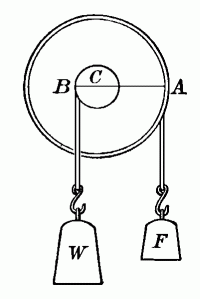 |
 |
| Jackscrew. | Wheel and axle. | Capstan. |
|---|
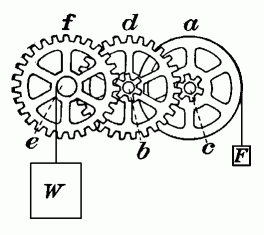 |
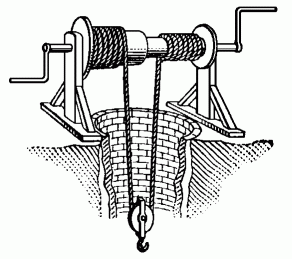 |
 |
| Gear train. | Differential windlass. | Worm gear. |
|---|
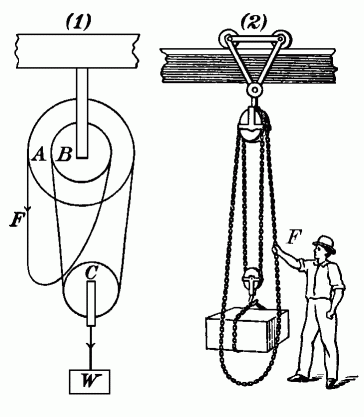 |
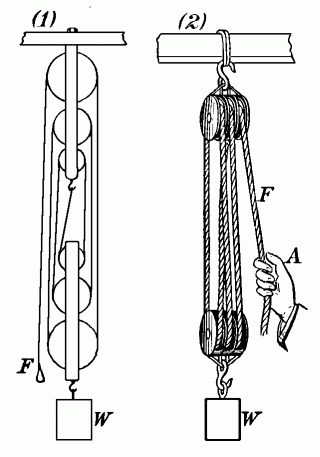 |
| Differential pulley and differential chain hoist. |
Block and tackle. |
|---|
 |
| Crane. |
|---|
6. QUESTIONS:
(1) High efficiency is not always desirable in a machine. What would happen if all friction were removed from a differential chain hoist, or from a jackscrew? What is the importance of friction in the capstan?
(2) Design a pulley operated "elevator" by which a you could lift yourself by your own power. Don't ignore the weight of any parts of the elevator which also must be lifted.
(3) What do the wheel and axle and the differential windlass have in common? How do they differ?
(4) Some books describe the jackscrew as a modification of the inclined plane. Discuss.
(5) Some books give a rule for finding the theoretical mechanical advantage of a block and tackle by counting the number of ropes supporting the weight. Figure out this rule, and state it.
(6) The capstan's purpose is much different from most other machines. It is used primarily to secure a heavy load without allowing the load to fall. It is found on ships and sailboats today, to aid in docking a boat to its moorings. The many wraps of rope around the capstan ensure high friction under tension. But as the tension on the rope decreases, the rope may be easily pulled, sliding easily around the capstan post. Some capstans are rigid. Some have a high friction wooden axle. Some modern ones are metal with a ratchet to prevent motion in one direction. Do some library research to find the many uses and types of capstans. Talk with someone who does sailing as a hobby.
(7) The illustration of Archimedes at the top of the page is decorative only. It raises some questions about this often-seen quotation. Where would Archie stand? What could provide a fulcrum? How could a lever this large work at all? Discuss. If all the conditions of the picture were satisfied, what ratio of lever arm lengths would be necessary?
The picture at the top of the page is from Mechanics Magazine, London, 1824.
Return to the contents page of this lab manual.
Return to the top of this document.
Return to Donald Simanek's home page.
© 1991, 2004, 2009 by Donald E. Simanek.